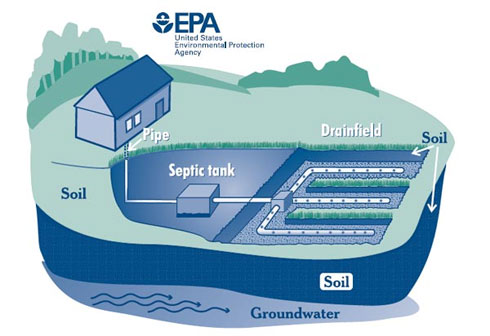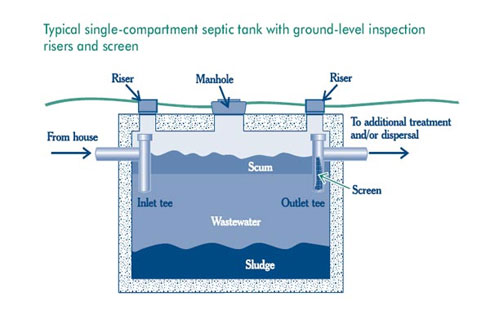
Did you know that maintaining your septic system protects your investment in your home? Did you know that you should periodically inspect your system and pump out your septic tank? If properly designed, constructed and maintained, your septic system can provide long-term, effective treatment of household wastewater. If your septic system isn’t maintained, you might need to replace it, costing you thousands of dollars. A malfunctioning system can contaminate groundwater that might be a source of drinking water. And if you sell your home, your septic system must be in good working order.
Components
A typical septic system has four main components: a pipe from the home, a septic tank, a drainfield, and the soil. Microbes in the soil digest or remove most contaminants from wastewater before it eventually reaches groundwater.
Pipe from the home. All of your household wastewater exits your home through a pipe to the septic tank.
The septic tank is a buried, watertight container typically made of concrete, fiberglass, or polyethylene. It holds the wastewater long enough to allow solids to settle out (forming sludge) and oil and grease to float to the surface (as scum). It also allows partial decomposition of the solid materials. Compartments and a T-shaped outlet in the septic tank prevent the sludge and scum from leaving the tank and traveling into the drainfield area. Screens are also recommended to keep solids from entering the drainfield. Newer septic tanks generally have risers with lids at the ground surface to allow easy location, inspection, and pumping of the tank .

Tip:
To prevent buildup, sludge and floating scum need to be removed
through periodic pumping of the septic tank. Regular inspections and
pumping as necessary (generally every 3 to 5 years) are the best and
cheapest way to keep your septic system in good working order.
The information on this page is a partial rendering of the document "A Homeowners Guide to Septic Systems" provided by the United States Environmental Protection Agency. More information and the document in free downloadable format is available at this web link: http://www3.epa.gov/npdes/pubs/homeowner_guide_long.pdf
